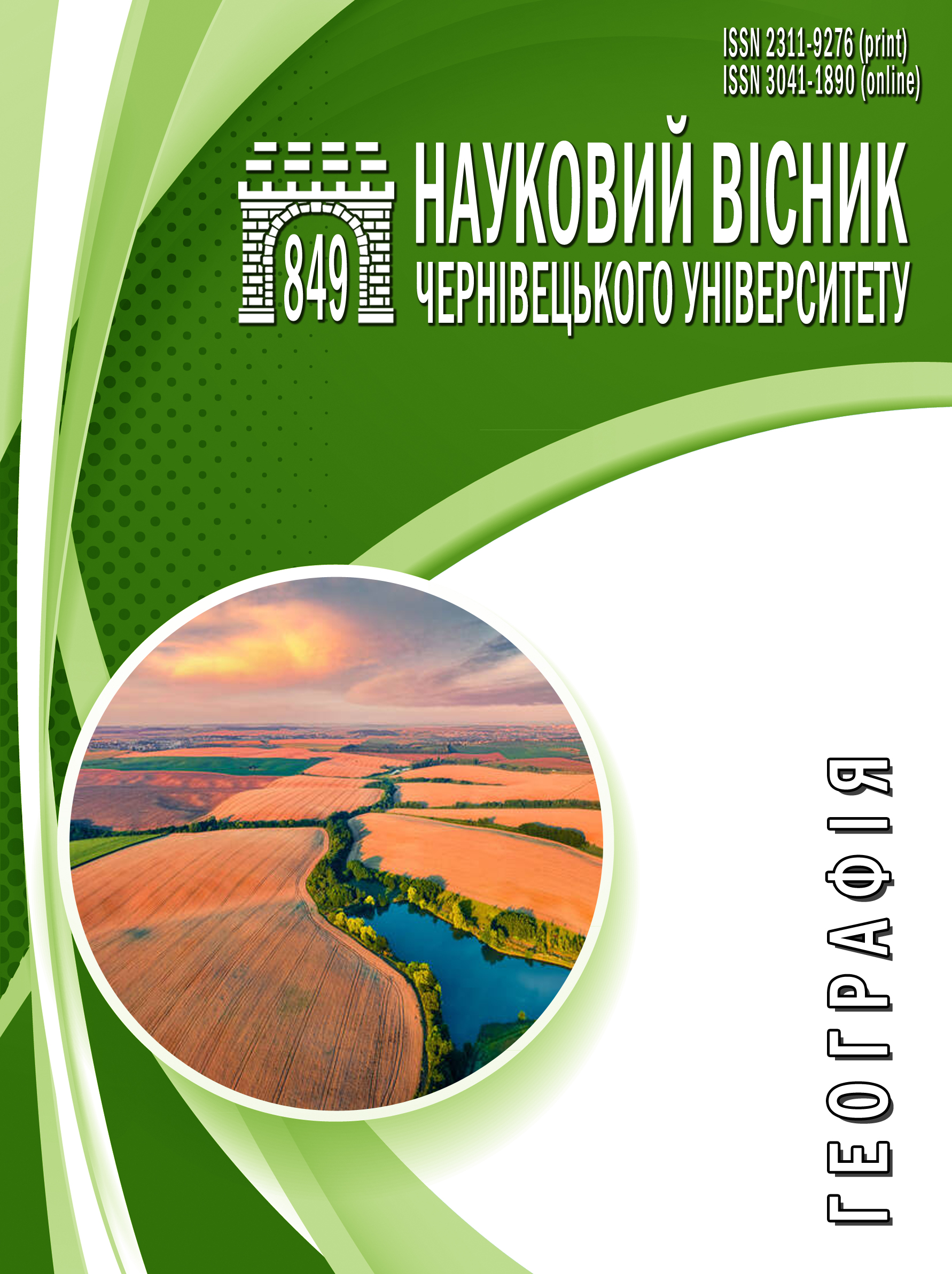Венеріанські вулканічні ксеноландшафти
DOI:
https://doi.org/10.31861/geo.2024.849.114-121Ключові слова:
ксеноландшафт, морфоструктура, Венера, вулкан, рельєфАнотація
Дослідження венеріанських ксеноландшафтів становлять важливий науковий виклик через їхню обмежену вивченість та специфіку доступних даних. Основна увага у працях приділяється ударним кільцевим структурам і вулканічним формаціям, які є ключовими об'єктами для ксеногеологічних та ксеногеоморфологічних інтерпретацій. На основі радарних зображень, отриманих з автоматичних міжпланетних станцій, було створено детальні моделі рельєфу Венери, що дозволяють ідентифікувати численні вулканічні й тектонічні форми, їхній розподіл і характеристики. Венера демонструє тривалу вулканічну активність, обумовлену її тепловим потенціалом. Близько 80 % поверхні планети вкрито екструзійними вулканічними матеріалами, включно з лавовими рівнинами, що є найбільшими у Сонячній системі. Зокрема, аналіз даних місії Magellan виявив понад 1 660 вулканічних елементів різного масштабу: від невеликих щитових вулканів до великих корон і лавових каналів. Основні типи вулканічних рівнин – сильно деформовані, помірно деформовані й недеформовані – відображають послідовні етапи розвитку планети. Кора Венери переважно базальтового складу та позбавлена води, що визначає її унікальні геодинамічні властивості, зокрема відсутність тектоніки плит і переважання підлітосферного механізму вулканізму. Концентрація вулканічних структур у регіонах Beta, Atla та Themis свідчить про сучасну активність, яку підтверджують локальні температурні аномалії, радіолокаційні дані та аналіз лавових потоків. Водночас стабільність глобального хмарного шару Венери, що складається переважно із краплинок сульфатної кислоти, також вказує на постійний вулканізм. Дослідження венеріанських вулканічних структур розширюють наше розуміння еволюції планети та геодинамічних процесів, що діють за умов високого тиску й температури. Подальші місії та технології радіометрії відкриють нові перспективи для моніторингу сучасного вулканізму й детального картографування поверхні Венери.
Посилання
Кирилюк, С. (2023). Формування вулканічних структур (на прикладі вулканів Венери). Міжнародна науково-практична конференція «Географічна освіта і наука: виклики і поступ», присвячена 140-річчю географії у Львівському університеті (Львів, 18‒20 травня 2023 року), 104-108. [Kyryliuk, S. (2023). Formuvannia vulkanichnykh struktur (na prykladi vulkaniv Venery). Mizhnarodna naukovo-praktychna konferentsiia «Heohrafichna osvita i nauka: vyklyky i postup», prysviachena 140-richchiu heohrafii u Lvivskomu universyteti (Lviv, 18‒20 travnia 2023 roku), 104-108.]
Baker, V. R., Komatsu, G., Parker, T. J., Gulick, V. C., Kargel, J. C., & Lewis, J. S. (1992), Channels and valleys on Venus: Preliminary analysis of Magellan data. Journal of Geophysical Research, (97), 13.421-13.445. https://doi.org/10.1029/92JE00927
Banerdt, W. B., McGill, G. E., & Zuber, M. T. (1997). Plains tectonics on Venus. Іn Venus II – Geology, Geophysics, Atmosphere, and Solar Wind Environment (pp. 901-930). Tucson : Univ. of Ariz. Press, Tucson.
Barker, E. S. (1979). Detection of SO2 in the UV spectrum of Venus. Geophysical Research Letters, 6(2), 117-120. https://doi.org/10.1029/GL006i002p00117
Basilevsky, A. T., & Head, J. W. (2002). Venus: Timing and rates of geological activity. Geology, (30), 1015-1018. https://doi.org/10.1130/0091-7613(2002)030<1015:VTAROG>2.0.CO;2
Bondarenko, N. V., Head, J. W., & Ivanov, M. A. (2010). Present‐day volcanism on Venus: evidence from microwave radiometry. Geophysical Research Letters, 37(23). CiteID L23202. https://doi.org/10.1029/2010GL045233
Campbell, B. A. (1999). Surface formation rates and impact crater densities on Venus. Journal of Geophysical Research, (104), 21.951-21.955. https://doi.org/10.1029/1998JE000607
Campbell, D. B., Head, J. W., Harmon, J. K., & Hine, A. A. (1984). Venus: Volcanism and rift formation in Beta Regio. Science, 226(4671), 167-170. https://doi.org/10.1126/science.226.4671.167
Crumpler, L. S., Aubele, J. C., Senske, D. A., Keddie, S. T., Magee, K. P., & Head, J. W. (1997). Volcanoes and centers of volcanism on Venus, Venus II. Geology, Geophysics, Atmosphere, and Solar Wind Environment, 697-756.
Fegley Jr, B., & Prinn, R. G. (1989). Estimation of the rate of volcanism on Venus from reaction rate measurements. Nature, 337(6202), 55-58. https://doi.org/10.1038/337055a0
Guest, J. E., & Stofan, E. R. (1999). A new view of the stratigraphic history of Venus. Icarus, (139), 55-66. https://doi.org/10.1006/icar.1999.6091
Hamilton, V. E., & Stofan, E. R. (1996). The geomorphology and evolution of Hecate Chasma. Icarus, (121), 171-194. https://doi.org/10.1006/icar.1996.0077
Hansen, V. L. (2000). Geologic mapping of tectonic planets. Earth and Planetary Science Letters, (176), 527-542. https://doi.org/10.1016/S0012-821X(00)00017-0
Hauck, S. A., Phillips, R. J., & Price, M. H. (1998). Venus: Crater distribution and plains resurfacing models. Journal of Geophysical Research, (103), 13.635-13.642. https://doi.org/10.1029/98JE00400
Head, J. W., Crumpler, L. S., Aubele, J. C., Guest, J., & Saunders, S. R. (1992). Venus volcanism: classification of volcanic features and structures, associations, and global distribution from Magellan data. Journal of Geophysical Research, 97(E8), 13153-13197. https://doi.org/10.1029/92JE01273
Head, J. W., & Wilson, L. (1986). Volcanic processes and landforms on Venus: Theory, predictions, and observations. Journal of Geophysical Research: Solid Earth, 91(B9), 9407-9446. https://doi.org/10.1029/JB091iB09p09407
Herrick, R. R., Izenberg, N., & Phillips, R. J. (1995). Comment on «The global resurfacing of Venus» by R. G. Strom, G. G. Schaber, D. D. Dawson. Journal of Geophysical Research, (100), 23.355-23.359. https://doi.org/10.1029/95JE02293
Herrick, R. R., & Sharpton, V. L. (2000). Implications from stereo-derived topography of Venusian impact craters. Journal of Geophysical Research, (105), 20.245-20.262. https://doi.org/10.1029/1999JE001225
Herrick, R. R., Sharpton, V. L., Malin, M. C., Lyons, S. N., & Feely, K. (1997). Morphology and morphometry of impact craters. Іn Bouger, S. W. Et al. (Еd.), Venus II (pp. 1015-1046). Tucson : University of Arizona Press.
Ivanov, M. A., Crumpler, L. S., Aubele, J. C., & Head, J. W. (2015). Volcanism on Venus. The Encyclopedia of Volcanoes, 729-746.
Ivanov, M. A., & Head, J. W. (2013). The history of volcanism on Venus. Planetary and Space Science, (84), 66-92. https://doi.org/10.1016/j.pss.2013.04.018
McGovern, P. J., & Solomon, S. C. (1997). Filling of flexural moats around large volcanoes on Venus: Implications for volcanic stratigraphy and global magmatic flux. Journal of Geophysical Research, (102), 16.303-16.318. https://doi.org/10.1029/97JE01318
McKinnon, W. B., Zahnle, K. J., Ivanov, B. A., & Melosh, H. J. (1997). Cratering on Venus: Models and observations. Іn Bouger, S. W. Et al. (Еd.), Venus II. (pp. 969-1014). Tucson : University of Arizona Press.
Namiki, N., & Solomon, S. C. (1994). Impact crater densities on volcanoes and coronae on Venus: Implications for volcanic resurfacing. Science, (265), 929-933. https://doi.org/10.1126/science.265.5174.929
Nimmo, F., & McKenzie, D. (1998). Volcanism and tectonics on Venus. Annual Review of Earth and Planetary Sciences, 26(1), 23-51. https://doi.org/10.1146/annurev.earth.26.1.23
Pavri, B., Head, J. W., Klose, K. B., & Wilson, L. (1992). Steep‐sided domes on Venus: Characteristics, geologic setting, and eruption conditions from Magellan data. Journal of Geophysical Research: Planets, 97(E8), 13445-13478. https://doi.org/10.1029/92JE01162
Phillips, R. J., & Hansen, V. L. (1994). Tectonic and magmatic evolution of Venus. Annual Review Of Earth And Planetary Sciences, (22), 597-654.
Phillips, R. J., Raubertas, R. F., Arvidson, R. E., Sarkar, I. C., Herrick, R. R., Izenberg, N., & Grimm, R. E. (1992). Impact crater distribution and the resurfacing history of Venus. Journal of Geophysical Research, (97), 15.923-15.948. https://doi.org/10.1029/92JE01696
Price, M. H., & Suppe, J. (1994). Mean age of rifting and volcanism on Venus deduced from impact crater densities. Nature, (372), 756-759. https://doi.org/10.1038/372756a0
Price, M. H., Watson, G., & Brankman, C. (1996). Dating volcanism and rifting on Venus using impact crater densities. Journal of Geophysical Research, (101), 4657-4671. https://doi.org/10.1029/95JE03017
Schaber, G. G. (1982). Venus: Limited extension and volcanism along zones of lithospheric weakness. Geophysical Research Letters, (9), 499-502. https://doi.org/10.1029/GL009i005p00499
Schaber, G. G., Strom, R. G., Moore, H. J., Soderblom, L. A., Kirk, R. L., Chadwick, D. J., Dawson, D. D., Gaddis, L. R., Boyce, J. M., & Russell, J. (1992). Geology and distribution of impact craters on Venus: What are they telling us? Journal of Geophysical Research, 97(E8) 13.257-13.301. https://doi.org/10.1029/92JE01246
Sharpton, V. L. (1994). Evidence from Magellan for unexpected deep complex craters in Venus. In Dressler, B. O. et al. (Ed.), Large meteorite impacts and planetary evolution (pp. 19-27). Geological Society of America, Special Paper 293.
Solomon, S. C., & Head, J. W. (1982). Mechanisms for lithospheric heat transport on Venus: Implications for tectonic style and volcanism. Journal of Geophysical Research: Solid Earth, 87(B11), 9236-9246. https://doi.org/10.1029/JB087iB11p09236
Squyres, S. W., Janes, D. M., & Baer, G. (1992). The morphology and evolution of coronae on Venus. Journal of Geophysical Research, 97(E8), 13611-13634. https://doi.org/10.1029/92JE01213
Strom, R. G., Schaber, G. G., & Dawson, D. D. (1994). The global resurfacing of Venus. Journal of Geophysical Research, (99), 10.899-10.926. https://doi.org/10.1029/94JE00388
Wichman, R. W. (1999). Internal crater modifi cation on Venus: Recognizing crater-centered volcanism by changes in fl oor morphometry and fl oor brightness. Journal of Geophysical Research, (104), 21.957-21.977. https://doi.org/10.1029/1997JE000428
Опубліковано
Номер
Розділ
Ліцензія
Авторське право (c) 2024 Науковий вісник Чернівецького університету : Географія

Ця робота ліцензується відповідно до ліцензії Creative Commons Attribution-NonCommercial-NoDerivatives 4.0 International License.


